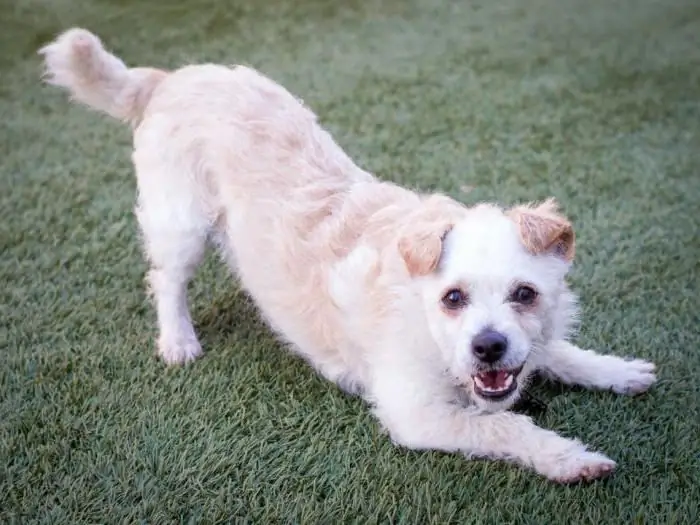2025 Author: Priscilla Miln | [email protected]. Last modified: 2025-01-22 17:55:21
Sometimes many of us are amazed at how smart our pet dogs can be. This is expressed in their behavior, and in their habits, and in many other ways. Sometimes they seem to understand us. But how well do we know them? How to understand the language of dogs? What do certain non-verbal signals from a pet mean? What does it mean if a dog flattens its ears or wags its tail? We will consider all this in the article.
The non-verbal language of dogs has been formed over thousands of years within a purely canine collective as a means of communication. Therefore, any state of a dog today can be very easily determined by its behavior, body language and other non-verbal signals that our four-legged pets show not only among themselves, but also in the human family. A lot of signs of states can be easily understood thanks to a translator from a dog language.
Satisfaction
Satisfaction is the most ordinary state of a dog. All parts of the body are relaxed, the ears are not pressed. The dog does not behave in any unusual way. Mouth closed or open for breathing.
Often a dog wags his tail when he feels calm, or keeps his tail in a normal position. It all depends on the breed.

Aggression
Aggressive dog becomes very dangerous. Signs of aggression appear in the fact that the dog begins to growl, baring its teeth, takes a position, as if it is about to attack, pushing its ears and body forward. And indeed it is. It's just that the animal is waiting for the right moment to attack. If the victim (another dog or person) makes a sudden movement, which the dog perceives as a real threat, then he may attack.
Often, this reaction comes with fear. It manifests itself as aggression. Only the dog, if possible, does not attack, looks away. At the same time, the muzzle is wrinkled with a grin and fangs are bare, but the body is compressed and the tail is pressed.
There is aggression of the dominant of the pack, when the dog shows its leadership by its behavior and influences other members of the pack. Usually these dogs put others in their place with a growl, a direct look, bared teeth and upturned ears.

The dog wants to play
When a dog wants to play, he tries with all his might to attract the attention of the owner: he runs up, jumps, pushes his nose, licks. Some dogs, if they like to play with toys, may take a ball or other object and bring it to a person.
Another signal of playfulness in a dog is his approach and distance from you or from another dog. Usually this alternates with jumping. When the pet jumps, it seems to lie down, sinking onto its front paws, and then bounce again. All the muscles of the animal are at the same time relaxed, and the tongue is sticking out.

Love, joy
Rejoicing dogs tend to wag their tails, fuss, sometimes jump towards their owner or roll around. Love also often manifests itself in licking. The dog may lie on its back to show its trust.
In such conditions, the muscles of the body and muzzle are as relaxed as possible, as the dog feels comfortable.

Submission
The manifestation of signs of obedience in the language of dogs is necessary in order to observe the hierarchy in the pack. The weaker dog shows the stronger one that it is not dangerous and is not going to attack.
Domestic dogs also often show obedience to people who are treated like older brothers. They lower their head and tail slightly, their ears are laid back, they look askance and avoid direct eye contact. Pets still use a similar position of the body and muzzle when they want to reconcile or feel guilty. This happens when the owners scold the dog for something.
Still very often, our tailed pets, when they feel a threat they want to prevent, or show their trust in the owners, lie on their backs.
Sadness
So-called dog sadness can manifest itself when a pet misses its owner. He starts to whine and maybe even howl a little. As a rule, when dogs are in this state, they behave very passively or lie down.

When annoyed, sad, dissatisfied, the tail and ears, as a rule, are pressed to the body, and the musclesrelaxed.
When dogs feel sad about being alone, they try to get their owners' attention by licking.
A state of fear
Fear in dogs is not to be confused with any condition. They begin to press their ears and tail, the hair may stand on end, and the body itself may take an unnatural pose. The body seems to bend, as if the dog is trying to appear smaller. The muscles are very tense. The dog may try to run away if possible.

Summarizing what has been said
So, to summarize:
- Tail wagging usually signifies joy or contentment. Dogs perform similar actions when they meet the owner or receive delicious food. And also dogs wag their tails if they feel calm and good. But this should not always be taken as a good sign, as the animal may slightly wag its tail when aggressive or fearful.
- Growling is a sign that the dog is aggressive, anxious or irritated.
- When a dog jumps, he is happy, wants to play or begs for something (for example, food that the owner holds in his hand). Often pets jump before a walk. The animal can be weaned from this habit if it is stopped with a firm voice and a subsequent reward.
- Eyes and gaze in the language of dogs also play a big role. But the correct interpretation depends on other non-verbal cues. So, in a dog with aggression, the eyes are very open and the gaze is motionless, but not directed into the eyes of the enemy. But if the dogon the contrary, she looks at you and lowers her head slightly or looks away when she meets you with her eyes, this means that she is submissive to you and is in a good mood.
- The position of the body can also change: the dog tries to either curl up into a ball, lower his head if he is scared or feels humiliated, or, on the contrary, stand on tiptoe, proudly lift his head when the dog shows that he is in charge here. That is, the dog says that it does not pose a threat, when it “decreases”, it shows humility. It shows its own dominance or aggression when it seems more than usual.
- Our tailed pets close their ears when they are afraid or express their humility, but rise in their normal state or when the animal is curious, surprised, enthusiastic.
- Whining pets usually show their longing and how they miss their owners. This is how they want to attract attention. Sometimes animals whine when they are scared.
- Licking is also a way to get attention or get a treat. But mostly dogs lick their owners after they meet to show their love and how much they missed them.
- Barking is the most controversial sound in animals. They may bark when they are afraid, aggressive, seeking attention, or being played. Animals usually use a high bark when they are afraid, and a low bark when they are experiencing aggression.
Do dogs understand human speech?
There is no doubt that dogs are very smart. Animals do not understand human speech. However, tailedpets are very sensitive to any changes in intonation and volume. And they also have a very developed memory. Therefore, a good ability to train and remember commands can be explained. Dogs can learn a lot of commands and words, but this is because they remember a combination of sounds and a certain intonation. They are also incredibly sensitive to human emotions.
And also dogs can understand what is required of them at the moment. Often, pets understand very well those people they know, that is, their owners. So we can conclude that dogs understand us in the same way that people understand the language of dogs.
Recommended:
How to understand that a girl wants a kiss: body language interpretation

Interpreting body language is a powerful psychological technique that allows you to understand the true intentions of another person. Some guys actively use this technique in a relationship to understand that a girl wants a kiss
The age of dogs by human standards. dog to human age ratio

It's no secret that our pets live much less than us. And this means that they grow and develop much faster. Each of us wondered: what is the age of dogs by human standards? This article will try to answer this question in as much detail as possible
The language of cats. Cat language - translator. Meowing cat - how to understand?

A cat is an amazing creation of nature. No animal is so expressive in the manifestation of feelings as this beast. A cat conveys all its emotions, attitudes through facial expressions, body movements, sounds, eye expressions and smells
How to understand that a girl wants you: signs and main manifestations. How to understand that a girl wants a relationship

How to understand that a girl wants you? The answer to this question excites any young person. In fact, it is only important to be a little more attentive and you can understand everything that is on the mind of the interlocutor without being a professional psychologist. By what signs can sympathy be recognized?
Learning to understand cat language

Cat language is not limited to ringing "meow" and soothing "murrr". There are also signs of the body and marks. Of course, we will not be able to understand the intricacies of the labels, but the remaining options are definitely within our power. This article will tell you how to learn to understand cat language

